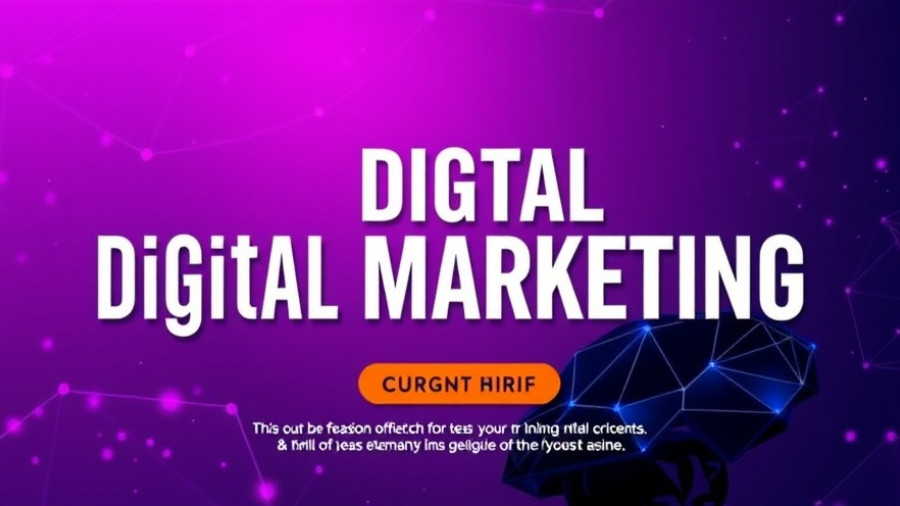
The Emerging Divide: B2B vs. B2C Marketing in the Age of AI
As businesses increasingly integrate artificial intelligence into their marketing strategies, a pronounced divide is surfacing between business-to-business (B2B) and business-to-consumer (B2C) approaches. Each sector is harnessing AI differently, shaping how marketers apply digital strategies, optimize customer engagement, and ultimately drive sales. Understanding these nuances is essential for professionals seeking to navigate the evolving landscape of digital marketing.
AI Revolutionizing Customer Experience
B2C companies often prioritize immediate engagement and personalized experiences to capture fleeting consumer attention. Technologies like chatbots and personalized recommendation systems, powered by AI, are becoming standard practice. For instance, brands like Amazon utilize advanced algorithms to analyze customer behavior, enabling hyper-personalized experiences that foster loyalty.
On the other hand, B2B marketing focuses on relationship-building and long sales cycles. AI tools such as predictive analytics are now being deployed to understand client needs better and forecast buying patterns. Companies like Salesforce highlight how predictive modeling helps identify ideal clients, refining lead generation efforts significantly.
AI Transforming Marketing Automation Tools
Automation plays a pivotal role in both B2B and B2C landscapes. However, the type of automation employed tends to vary. B2B marketers often use sophisticated CRM systems integrated with AI to streamline lead nurturing processes, closely tracking customer interactions to optimize touchpoints. By contrast, B2C marketers leverage marketing automation primarily for campaigns directed at immediate sales conversions.
The convergence of these two approaches is where exciting innovation occurs. Tools that integrate AI across multiple channels allow marketers to create omnichannel strategies that deliver a cohesive experience, regardless of whether the audience falls under B2B or B2C categories.
Social Media Strategies Shaping Engagement
Social media platforms have become essential in bridging the gap between B2B and B2C marketing strategies. B2C brands predominantly use platforms like Instagram and TikTok to create visually appealing content that resonates emotionally with consumers. Campaigns often include interactive features and influencer collaborations to trigger immediate reactions.
B2B companies, while traditionally more reserved in their social strategies, are beginning to adopt similar tactics. LinkedIn is emerging as a powerful tool for B2B engagement, with companies sharing thought leadership content that builds brand authority and fosters community conversations. This blend showcases how AI can optimize content distribution based on audience behavior across varying social platforms.
Marketing ROI: Tracking Success Differently
Another critical difference between the two marketing types lies in measuring ROI. While both sectors utilize data analytics to evaluate performance, B2C marketers often prioritize immediate responses like clicks and sales conversions. In contrast, B2B marketers focus on metrics related to lead generation and customer retention. They look at long-term value over immediate profits, which can require more nuanced data analysis techniques that AI tools readily support.
Future Predictions: The Constant Evolution of Marketing Strategies
Looking ahead, the impact of AI on both B2B and B2C marketing will likely accelerate. Experts predict that businesses will increasingly invest in AI-driven tools for deeper analytics, allowing for even more targeted marketing strategies. The rise of voice search and augmented reality could further transform personalization efforts across both sectors.
Moreover, as digital marketing trends continue to evolve towards sustainability and ethical practices, both B2B and B2C companies may find common ground in leveraging AI to better align with customer values. Marketers will need to adapt their strategies, ensuring they maintain a balance between technological advancements and genuine customer engagement.
Practical Insights: Navigating the AI-Driven Future
For professionals and business owners, staying current with AI marketing trends is vital. Adopting a continuous learning mindset through webinars, workshops, and digital certificates can equip marketers with the necessary skills. Implementation requires not just knowledge but a willingness to experiment and analyze what resonates best with their audience.
Moreover, leveraging data-driven insights can help businesses target their marketing efforts effectively, allowing for improvements in both B2B and B2C campaigns. As marketers combine AI tools and robust analytics, tailoring strategies to meet the specific nuances of their audience will yield significant dividends in the long run.
 Add Row
Add Row  Add
Add 




Write A Comment